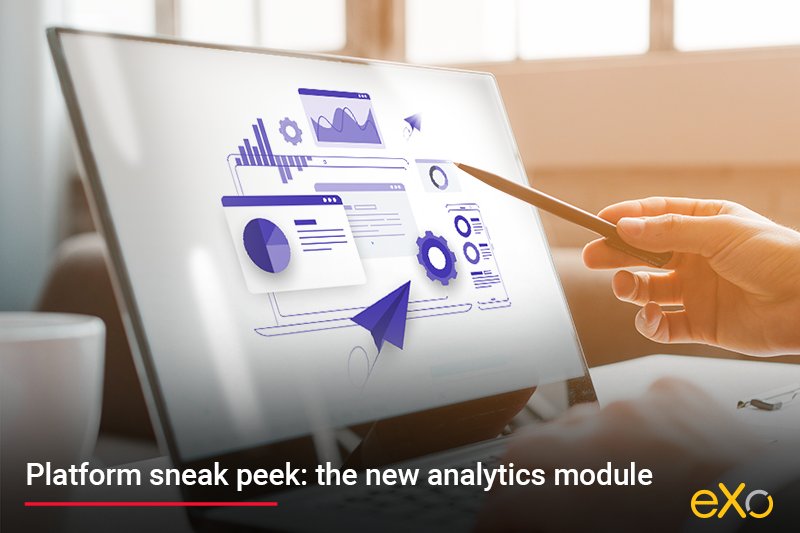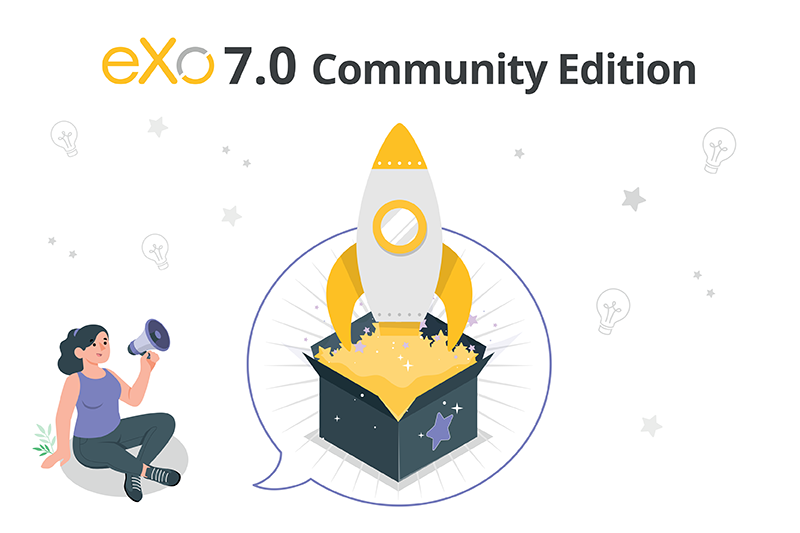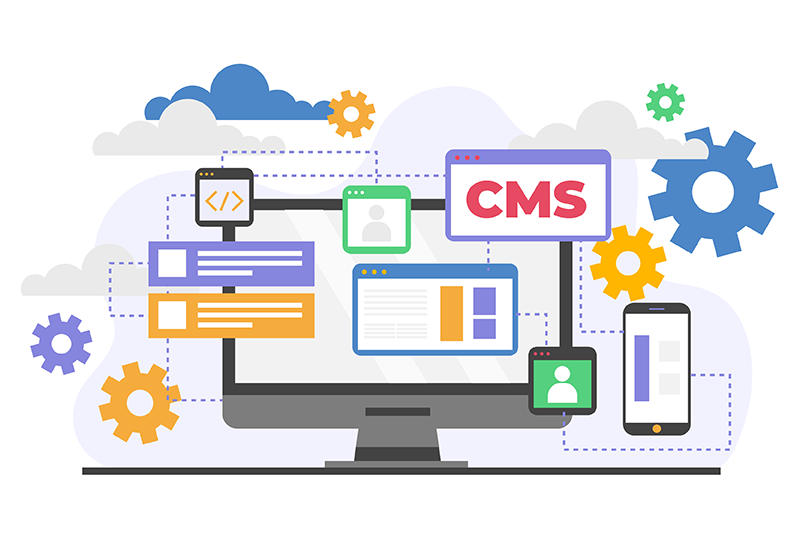- Fares Laroui
- May 19, 2021
Platform sneak peek: the new analytics module

Content
In relation to the employee digital experience and the new ways of working, we can’t talk about a successful adoption without collecting and measuring data. This is why administrators require a digital workplace analytics module that can help them collect, measure and analyze various types of data to manage their digital workplace effectively.
Throughout our major releases, we have always attempted to equip our users with the appropriate analytical tools (such as the Lecko analytics engagement add-on) to achieve just that.
In this blog post, we are going to introduce the new built-in analytics module for eXo Platform and explore its main capabilities.
tools and information
eXo analytics module at a glance
To build on the existing analytics capabilities, a dedicated feature team at eXo has been recently tasked with developing a new digital workplace analytics module to satisfy the growing expectations of both our clients and community members and facilitate the handling and analysis of data directly within eXo Platform.
This new add-on is designed to help digital workplace administrators collect and track key metrics that mainly revolve around adoption, usage and engagement within the platform as a whole or specific collaborative spaces.
Without having to refer to third-party providers, admins can perform a variety of actions including, but not limited to, the following:
Assess user adoption levels
Audit and analyze various user activities:
Using the new digital workplace analytics module, you will be able to monitor user activities within specific apps such as drives, tasks, agenda, notes, chat and video conferencing. This will help you contextualize the adoption rates above and identify the most popular and used applications.
Additionally, you will be able to classify users into different personas (active users, knowledge contributors or consumers, networkers, etc.) based on the applications they use, how often they contribute and how much they interact with content on the platform.
Track and inspect user engagement levels:
Employee engagement scores are among the key indicators of the well-being of employees and the success of the digital workplace project as a whole. If employees find the platform useful and engaging, then they are intrigued to use it and the scores would eventually be high. If not, then users will slowly lose interest and refer to other solutions (or even their own) and the scores will go down.
Digital workplace administrators need to have an overview of engagement trends and users’ social activities within the platform in order to assess user engagement and act accordingly by either building on successful initiatives or reviewing failed ones.
The new analytics module provides a detailed view of engagement levels of both the overall platform users or individual ones. Social activities are grouped under one main module: “Social”. Every time a user performs an activity (such as creating, liking, commenting on a post, completing a profile, sending a kudos, etc.), the activities count will appear on the analytics main menu. Additionally, with the availability of the custom time selector, you can compare metrics over a custom period of time, giving you a clear indication of user engagement trends over time.
Identify the digital workplace reach
With remote working becoming the new reality for many businesses, it is important for digital workplace administrators to figure out whether their digital workplace reaches their remote employees or on-site/frontline employees. The formula is fairly simple: divide the number of unique logins by the total number of employees on the platform.
Both metrics are available by default on the analytics main menu. To make matters easier, we have introduced a percentage chart that provides you with the percentage of connected users currently on the platform relative to the overall platform users. Furthermore, below the percentage chart, you can visualize the evolution of reach compared to a previous period of your choice.
Compare different metrics over predetermined time periods
Create custom report and dashboards
What’s new?
Compared to the basic analytics module available on our previous versions, this new module comes with an easier navigation and more detailed metrics all grouped within analytics pages. The latter act as a dashboard, containing all relevant information about both users and spaces.
Let’s explore each page in further detail.
Analytics main dashboard
The analytics main page is accessible directly from the applications centre. It gives you a snapshot of the most important metrics to keep an eye on. Upon accessing the application, you will have an overview of six main charts:
- User count chart: the number of users – both internal and external – on the platform
- Distinct login chart: the number of logins, giving you a clear indication of adoption levels
- Connected users’ chart: the percentage of connected users relative to the number of users across the entire platform
- Analytical chart: the percentage of activities performed by the top 10 per cent of most active users in relation to all activities across the entire platform
- Space count chart: the number of spaces created on the platform over time
- Activities chart: This pie chart indicates the number of activities performed by users per module (i.e. discussions, drives, tasks, social, notes, agenda, etc.). This metric allows you to understand how users interact with the platform and which applications are the most important for each user or group of users.
Digital Workplace Solutions
User analytics
To gain a better understanding of the activities performed by individual users, we have decided to implement a user analytics page accessible from the main analytics menu.
There you will find a table with detailed data about each user. The table contains the following columns by default:
- the creation date of each user’s profile
- the date of each user’s last connection
- the count of connections per user
- the count of each user’s activities
- the module most used by an individual user.
It is worth noting that as the platform admin, you are able to customize the table by adding a custom time period in which you want to display the above data. Additionally, you can add and remove columns and/or sort some based on an ascending/descending order. For example, you can modify the order of last connections from the oldest to the more recent or the number of connections count or the number of activities performed from least to greatest.
Space analytics
Similar to the user analytics, the space analytics pages give a snapshot of the main activities within the platform’s collaborative spaces during a time frame that you select. The page contains a rich table that contains the following columns:
- the creation dates of the spaces
- the total number of space members during the selected period with a comparative indication with the previous period
- the percentage of active members (i.e. members who contribute and use the space’s built-in applications) with a comparative indication with the previous period
- the count of activities in the space
- the module most used by space members.
The new analytics module will soon be available on our upcoming release eXo Platform 6.2. Until then, our different teams will continue to test and gather feedback internally to optimize this new feature and make further additions for an optimal result.
If you would like to know more about our latest and upcoming features, make sure to take the blog tour or visit the roadmap here. For an in-depth look at eXo Platform, we invite you to contact us and book a demo with our expert consultants.
company intranet
FAQ
What is an intranet?
intranet is a term used with abundance whenever the subject of internal communication and collaboration is brought up which makes defining it a bit challenging. In its simplest form, an intranet is an internal website for your organization. It is used mainly for top-down communication where employees can access corporate news, policies and announcements.
What are the different types of intranet solutions?
To gather a thorough understanding of intranets and their different types, let’s walk through its history from the early days up to now:
- Intranet Portals
- Enterprise Social Netwrok (ESN)
- Intranet 2.0
What is the difference between intranets and extranets?
The main difference between intranets and extranets lays in the target audience. Intranets typically target users from a specific organization whereas extranets is the hub that can group users from multiple external organizations ranging from partners and suppliers all the way to clients
➝ Discover the real difference between intranet and extranet
What are the benefits of intranet solutions?
Different types of Intranet solutions from the early days up to the intranet 2.0 (commonly referred to as digital workplace solutions) bring a host of benefits to businesses of all sizes and industries. Below is a list of benefits often associated with intranets:
- Streamline internal communications
- Connect employees and eliminate silos
- Foster collaboration
- Improve knowledge sharing
- Recognize and reward employees
What are the different strategies for a successful intranet adoption?
Here are three different strategies for a successful intranet adoption:
- User focus strategy
- Global community management strategy
- Private communities focus strategy
Related posts
- All
- eXo
- Digital workplace
- Employee engagement
- Open source
- Future of work
- Internal communication
- Collaboration
- News
- intranet
- workplace
- Knowledge management
- Employee experience
- Employee productivity
- onboarding
- Employee recognition
- Change management
- Cartoon
- Digital transformation
- Infographic
- Remote work
- Industry trends
- Product News
- Thought leadership
- Tips & Tricks
- Tutorial
- Uncategorized
Leave a Reply
( Your e-mail address will not be published)


